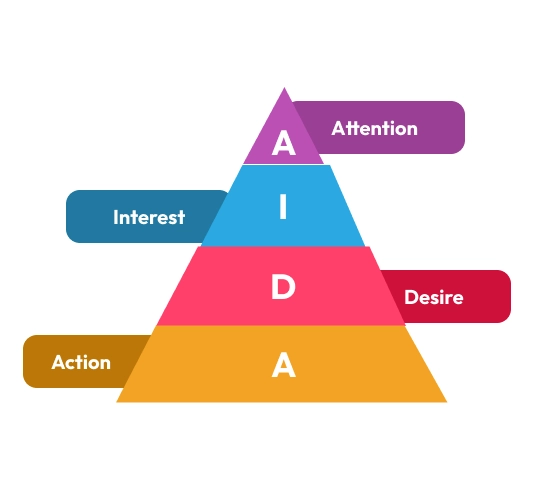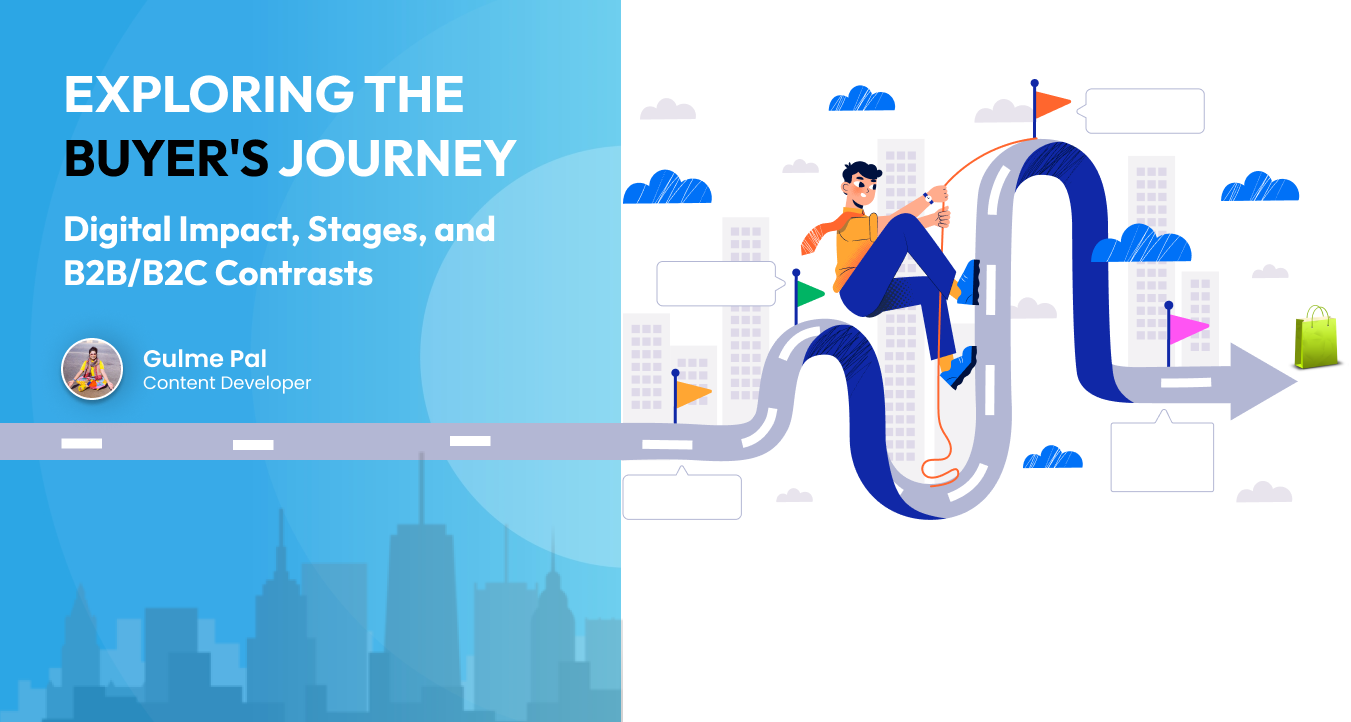Knowing the phases of the buyer journey enables marketers to send the appropriate message at the appropriate moment. Employing buyer journey stages as a component of a larger marketing plan is similar to having a treasure map that leads companies, one step at a time, toward quantifiable success.
Starting a consumer's purchasing journey is a thrilling endeavour that is outlined by a sequence of steps called the Buyer's Journey. We set out on a digital journey through the complex world of business and explore the fascinating area of the buyer's journey. This journey sheds light on the phases influencing consumer choices from awareness to acquisition. This journey has experienced an unprecedented evolution in the field of digital commerce, altering the way businesses engage with their customers. Understanding this approach is not just an operational decision; it is an important prerequisite for businesses negotiating today's cut-throat environments.
What is the usefulness of the Buyer's Journey in the digital era? This query acts as an indicator of light for us as we explore the complexities of consumer decision-making. The secret to customized marketing strategies, whether negotiating the B2B maze or winning over the discerning B2C audience, lies in solving this riddle. We will break down the phases of the buyer's journey in this piece, pinpoint the digital footprint that influences each stage, and make enlightening contrasts between B2B and B2C scenarios.
From awareness to purchase, each stage of the buyer's journey provides a distinct possibility for businesses to interact with, sway, and eventually turn leads into devoted patrons. Come along on the present study as we unravel how the digital environment affects the Buyer's Journey and understand its importance in the modern, interconnected business ecology.
By dissecting the intricacies that characterize the modern marketplace, let's traverse the avenues of consumer decision-making.
The Digital Influence on the Buyer's Journey
- Progress of Buyer’s Journey in the Digital Age:
- Changes in the buyer's journey from linear to non-linear and dynamic.
- Improved consumer empowerment through easier access to information.
- Data on Digital Media Influence:
- 73% of consumers and 4000 business buyers worldwide surveyed in 2022 expressed the expectation that businesses would be aware of their particular needs and preferences.
- B2B/B2C Contrasts:
- Importance of relationship-building in B2B transactions.
- Different levels of complexity in B2B vs B2C decision-making.
Comprehending these facets highlights the significant influence of the digital terrain on customers and enterprises, underscoring the necessity of tactical digital involvement throughout the buyer's journey.
What are the three stages of the buyer's journey?

The perspectives of both B2B and B2C buyers’ journeys are different in terms of their stages. The stages are:
1. Awareness Stage
Modern commerce relies heavily on an understanding of the buyer's journey, which consists of three essential stages. Content marketing is essential in the Awareness Stage for drawing attention, increasing brand recognition, and laying out the foundation for later stages.
2. Consideration Stage
Businesses looking to succeed in the vast world of digital commerce must grasp the buyer's journey. The Consideration Stage, where awareness piques interest; the Evaluating Options stage, where prospects conduct an in-depth scrutiny and and the Critical Phase of Decision-Making.
3. Decision Stage
At the key is the Decision Stage, where buyers make their ultimate purchasing decision. Strategic marketing that highlights the positive aspects of the product and its USP is necessary to get through this stage.
| Stages | B2B Perspective | B2C Perspective |
| Awareness |
The customer determines that business operations need to be streamlined and assigns one or more employees to find a suitable solution. To fulfil their responsibilities, employees might evaluate the organization's current needs and procedures, establish project objectives, and determine which tasks and procedures could be automated. For example:
|
Word-of-mouth or traditional and social media advertisements help the consumer learn about the product. For example:
|
| Consideration |
The customer investigates ERP options after determining their present needs and objectives. Depending on its scope, a variety of stakeholders may be implicated in this stage. Several rounds of meetings, information assembly, and sharing between the customer and possible vendors may be part of this process. For example:
|
The consumer adds that specific product to their shopping list after realizing they must purchase it. For example:
|
| Decision |
A small list of potential ERP suppliers is chosen by the customer, who then requests quotes from each. Senior management from the vendor and the customer may be involved in making decisions at this point. For example:
|
The customer chooses and purchases the item while they are out shopping. Their purchasing decision may be influenced by price, special offers, or brand loyalty. For example:
|
The final step, Making the Purchase, represents a critical digital impact. It's significant to bring up the loyalty of customers after a purchase. There are dissimilarities between B2B and B2C, with B2B putting more value on relationships and B2C favouring experiences that are more specific. Gaining success in the digital sphere and building enduring relationships require mastering these stages.
How Much of the Buyer's Journey is Digital?
- Analysing the Dominance of Digital Channels
The buyer's journey is becoming more digital. According to the Research, more than 75% of consumers start their search online, focusing on the main role that digital channels play in the consumer journey.
Digital channels, including social media and search engines, are necessary for regulating consumer choices. Businesses hoping to effectively influence consumer behaviour in buying decisions need to understand how customers interact with these platforms.
- Impact of Online Research and Social Media
Before making a purchase, consumers frequently conduct research online. During this stage, social media platforms serve as influential touchpoints where decision-making is greatly influenced by recommendations and reviews.
In B2B and B2C scenarios, the digital impact is different. While social media and visually appealing content are often well-received by B2C buyers, B2B buyers might place more value on in-depth research from trade journals and professional networks.
Appiness provides a notable example of a successful integration. Businesses must grasp the digital nuances of the buyer's journey.
At the point of checkout, three out of every four online shoppers will abandon their cart in 2023. The majority of the most common excuses for abandoning a cart were unwelcome interruptions (excessive post-purchase fees, the website requiring account creation, or a lack of trust from the customer). Whether your business is B2C or B2B, giving customers a wonderful experience is essential.
Difference Between B2B and B2C Buyer Journey
- Processes of Making Decisions
- Comparing a B2B and B2C journey, the former emphasizes more extensive, intricate decision-making involving multiple stakeholders.
- B2C transactions are frequently shorter and more emotionally charged, involving just one customer making the choice.
- B2B decision-making processes such as discussions, in-depth study, and a prominence on long-term value.
- Instant requirements, emotions, and urges play a role in B2C decision-making.
- Significance of Relationship Building in B2B
- B2B Relationship Building: B2B places a strong focus on developing relationships and trust.
- B2C transactions tend to be more transactional and place less value on long-term associations.
- Digital Impact: Digital platforms have an important effect on both B2B and B2C transactions.
- Lead nurturing in B2B is virtuoso through webinars, content marketing, and customized interactions.
- B2C utilises influencers, social media, and targeted advertising to interact with customers.
Buyer's Journey in Digital Marketing
At every stage, it's significant to strategically use digital platforms. Social media and content marketing are essential tools for relying on potential customers during the awareness phase. Turning now to consideration, webinars and email campaigns increase participation. As conversions approach, the decision stage notices the effectiveness of individual encounters and endorsements.
The journey is seamless because of useful tools and strategies. Marketing automation expedites communication, while analytics tools monitor consumer behaviour. Chatbots improve customer experience by offering real-time support. By comprehending and employing these digital dynamics, companies can maintain their relevance and influence throughout the buyer's journey, establishing enduring partnerships in the digital era.
Conclusion
In the final analysis, businesses looking to succeed in the competitive marketplace must understand how to navigate the buyer's journey in the digital age. Comprehending the three stages of Awareness, Consideration, and Decision furnishes a framework for specific advertising approaches. Undoubtedly, digitalization has had a profound impact, changing the journey from linear to non-linear, empowering customers, and necessitating strategic engagement. The differences between B2B and B2C highlight how important it is to forge relationships in B2B and provide specific experiences in B2C.
Businesses must adapt because digital channels, such as social media and online research, are becoming more and more prevalent. In the age of digital media, targeted approaches which make use of technologies like marketing automation ensure relevance and influence at every stage of the buyer's journey and build long-lasting relationships.
One noteworthy illustration of effective integration is Appiness. Since the digital buyer journey now accounts for about 80% of the buyer journey, marketers need to use customized strategies that take into account the unique characteristics of each stage and buyer type. Understanding the buyer's journey is essential to long-term success in this networked business ecosystem.




